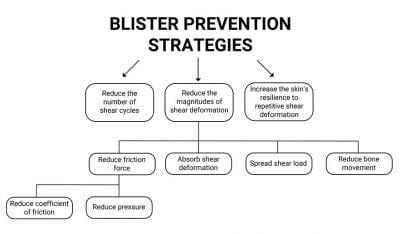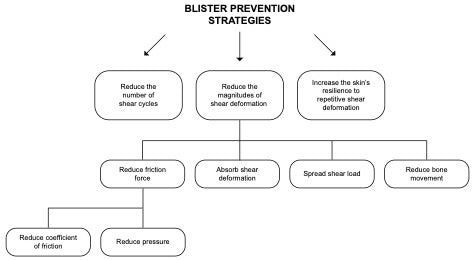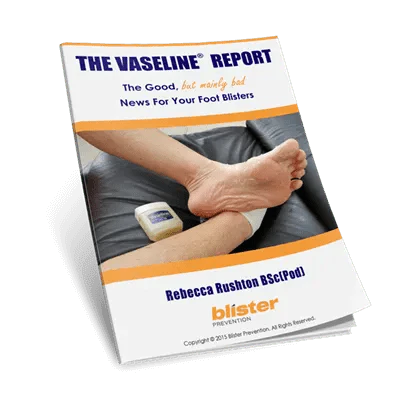The best bister prevention strategies hone in on the blister causing factors, plus a couple of other shear-minimisation strategies. Let’s go through how to prevent blisters on feet, one by one.

BLISTER PREVENTION STRATEGIES
1. Reduce The Number Of Shear Cycles
This one’s a tricky one in athletic situations. It amounts to not walking or running as far, or not playing as long. Sure, you can technically call this a blister prevention strategy. But because it has limited practical benefit, we’re going to ignore this one.
2. Increase Your Skin’s Resilience to Shear
Research has demonstrated that we can make our skin more resilient to shear distortions and therefore more resistant to blister formation by subjecting our skin to these forces. Examples include:
3. Reduce Friction Levels (Coefficient of Friction )
When you reduce friction, most people think you’re trying to stop rubbing. In reality, you’re trying to make things more slippery. This slippery surface (either on your skin, between sock layers or on your shoe) will reduce the skin from stretching (shearing) too much. Ideally, the aim is to make it more slippery just where the blister-susceptible area is, not all over the foot. Remember the mechanical efficiencies of gait – we still need high-ish friction levels to maintain traction for the foot in the shoe. Examples of COF reduction strategies include:
- Antiperspirants
- Astringents
- Moisture-wicking socks
- Changing socks when they’re wet
- Allowing the feet to air-dry
- Powders
- Lubricants
- Double-sock systems
- ENGO patches
- Low friction tapes
4. Reduce Pressure
There is a lot of pressure on all parts of our feet from weightbearing, shoe contact pressure and from toes sitting so close together so it’s easy to see why blisters are so common on the feet, especially when running, jumping and walking over difficult terrains. Examples include:
- Cushioned insoles
- Gel toe protectors
- Donut pads
- Well-fitting footwear
- Footwear modifications
- Orthotics and custom made insoles
- Thicker socks
- Toe-socks
- Toe-props
- Wool
5. Minimise Bone Movement
If you can reduce the amount the bones move relative to the skin surface, you’ll be reducing the magnitude of skin shear distortions. Examples include:
6. Shear Absorption
If you can use materials that undergo shear within their layers, there will be less shear required within the soft tissues of the foot. Examples include:
7. Spread Shear Load
Peak shear occurs in very localised areas. It’s likely that if you can spread that shear load over a larger area, peak shear will be reduced per unit area. I believe this is how tapes work because it’s unlikely they work by any other mechanism (for example, they are unlikely to be made from low friction materials).
STILL GOT QUESTIONS ABOUT HOW TO PREVENT BLISTERS ON FEET?
The best blister prevention strategy will depend on your blister location and what’s causing that blister. For example, is your toe blister caused by the depth of your shoe’s toebox, the shape of your toe, the toe bending over when you walk and run, or something else. Learn how to prevent foot blisters in this very specific way by either typing your blister location in the box below:
Search for:
Or click below to enrol in my course and I’ll walk you through it.






